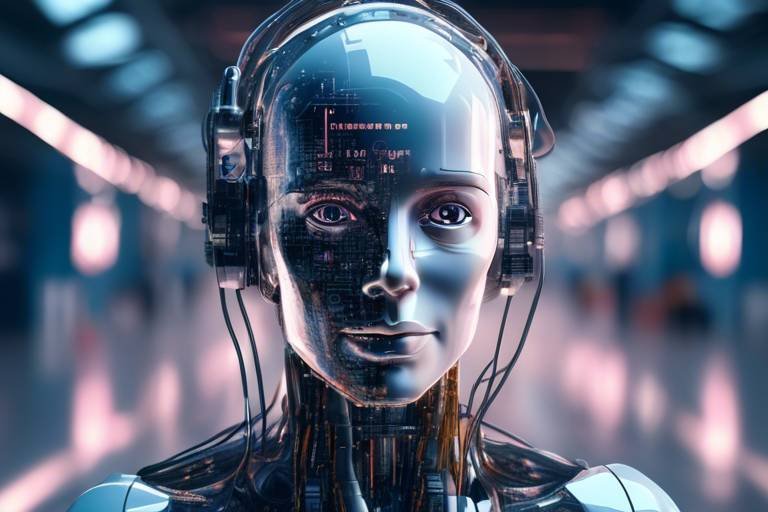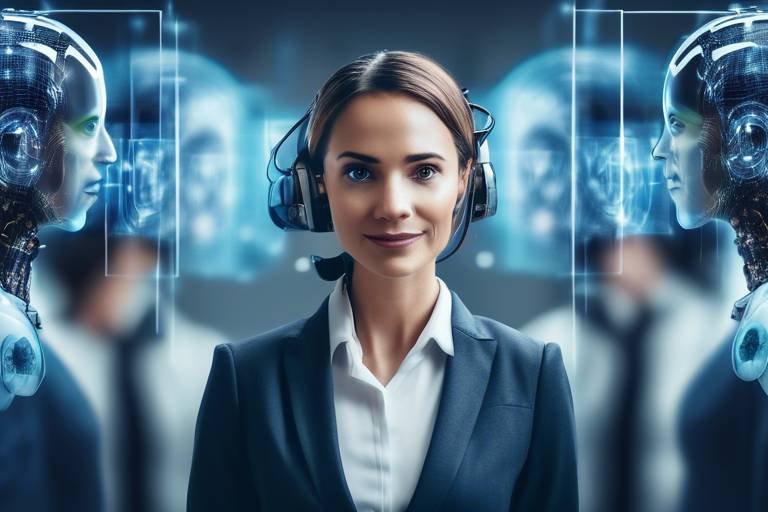How to Prepare for an AI-Dominated Future at Work
As we stand on the brink of a technological revolution, the presence of artificial intelligence (AI) in the workplace is no longer a distant future; it's happening right now. This evolution brings a wave of excitement and uncertainty, prompting both individuals and organizations to rethink their strategies for success. So, how can you navigate this rapidly changing landscape? The key lies in understanding AI's impact, honing the right skills, and fostering a culture that embraces change.
Artificial intelligence is reshaping industries at an unprecedented pace. From automating mundane tasks to analyzing vast amounts of data for insights, AI is not just a tool but a transformative force. It's essential to grasp both the opportunities and challenges AI presents. For instance, while AI can enhance productivity and efficiency, it also raises concerns about job displacement and the need for new skill sets. By recognizing these dynamics, individuals can better prepare themselves for the future job market.
In an AI-driven environment, certain skills will become increasingly valuable. It's not just about technical know-how; a blend of technical, analytical, and soft skills will be crucial for success. Think of it as building a toolbox: the more diverse your tools, the better equipped you are to tackle various challenges.
Let's dive deeper into the technical skills that will be in high demand. Skills like coding, data analysis, and machine learning are no longer reserved for tech experts; they are becoming essential for professionals across all fields. For example, understanding how to interpret data can give you a competitive edge in decision-making processes.
In today's data-driven world, being data literate is akin to being fluent in a new language. It allows you to interpret and utilize data effectively, making you a valuable asset in any organization. Imagine being the go-to person who can turn numbers into actionable insights—how empowering would that be?
When it comes to programming, languages like Python and R are essential for interacting with AI systems. These languages not only help you understand AI better but also enable you to develop innovative solutions tailored to your industry. Think of them as the keys to unlock the potential of AI in your work.
While technical skills are vital, let’s not underestimate the power of soft skills. Traits like creativity, emotional intelligence, and adaptability will complement your technical abilities, fostering collaboration in AI-centric teams. Imagine working in a team where everyone is not just skilled but also understands each other’s strengths and weaknesses—how much more effective would that team be?
In an era where change is the only constant, adopting a mindset of continuous education is crucial. Lifelong learning ensures that you keep pace with rapid technological advancements and evolving job requirements. It’s about being proactive rather than reactive in your career development.
Many online learning platforms offer courses that can help you upskill and stay relevant. Websites like Coursera, Udacity, and LinkedIn Learning provide a plethora of resources tailored to various fields. Think of these platforms as your personal learning hub, where you can explore new technologies and trends at your own pace.
Building professional networks is another key strategy for navigating the AI-driven future of work. Collaborating with peers allows you to share knowledge, experiences, and insights. Imagine attending a workshop where ideas flow freely, and everyone leaves with a fresh perspective—networking is about creating those moments.
As AI continues to evolve, job displacement is a reality that cannot be ignored. However, there are strategies individuals and organizations can implement to mitigate its impact. Preparing for this shift involves being proactive and resilient.
Employers should invest in reskilling programs to help employees transition to new roles as AI technologies reshape the job market. These initiatives not only benefit the workforce but also enhance organizational loyalty and morale. It’s a win-win situation!
Effective career transition planning involves identifying transferable skills and exploring new job opportunities. It’s essential to be flexible and open-minded about where your career path may lead you. Think of it as a journey—sometimes, the road less traveled can lead to the most rewarding destinations.
Organizations must create environments that embrace AI technologies, encouraging innovation and collaboration. This culture of adaptability will empower employees to thrive alongside AI.
Best practices for integrating AI into workflows include training employees on new systems and ensuring they understand how to leverage these technologies effectively. It’s about enhancing productivity while making sure everyone feels equipped to use the tools at their disposal.
Fostering a culture of innovation is vital. Encourage employees to explore new ideas and leverage AI tools to drive business growth. When employees feel empowered to innovate, the entire organization can benefit from fresh perspectives and solutions.
As we embrace AI, we must also consider the ethical implications of its use in the workplace. Issues like fairness, transparency, and accountability need to be addressed to create a responsible AI ecosystem.
It’s crucial to ensure fairness in AI algorithms to prevent bias and discrimination in hiring and promotions. By promoting an equitable work environment, organizations can build trust and foster a culture of inclusivity.
Transparency regarding AI applications is essential for fostering trust among employees and stakeholders. When everyone understands how decisions are made, it creates a sense of security and collaboration within the organization.
Q1: How can I start learning about AI?
A1: Consider enrolling in online courses or workshops focused on AI and its applications in your industry. Platforms like Coursera and Udacity offer excellent resources.
Q2: Will AI take away my job?
A2: While AI may change job roles, it also creates new opportunities. Upskilling and embracing lifelong learning can help you stay relevant in the evolving job market.
Q3: What soft skills are important in an AI-driven workplace?
A3: Skills such as creativity, emotional intelligence, and adaptability will be crucial for collaborating effectively in AI-centric teams.

Understanding AI and Its Impact
Artificial Intelligence (AI) is no longer a concept confined to science fiction; it has become a powerful force reshaping our workplaces and daily lives. Imagine a world where machines can learn from experience, adapt to new inputs, and perform tasks that typically require human intelligence. That's the reality we're stepping into, and it’s crucial to grasp how AI is transforming industries and job roles. The capabilities of AI are vast, but let’s break them down into more digestible pieces.
At its core, AI encompasses technologies that enable machines to perform tasks that usually require human intellect. This includes natural language processing, machine learning, and computer vision. These technologies are not just buzzwords; they are the engines driving innovation in sectors such as healthcare, finance, manufacturing, and beyond. For instance, in healthcare, AI algorithms can analyze medical images with remarkable accuracy, assisting doctors in diagnosing diseases faster than ever before.
However, with great power comes great responsibility. The rise of AI also presents significant challenges. Job displacement is a primary concern, as automation threatens to replace routine tasks traditionally performed by humans. According to a recent study, it’s estimated that up to 47% of jobs in the U.S. could be at risk due to automation and AI advancements. This statistic can be alarming, but it also opens the door to new opportunities for those willing to adapt and learn.
As we delve deeper into the impact of AI, it's essential to recognize both the opportunities and challenges it brings. Here’s a quick look:
- Opportunities: Enhanced productivity, new job creation in tech fields, and improved decision-making processes.
- Challenges: Job displacement, ethical concerns, and the need for new skills in the workforce.
In the modern workplace, understanding AI is not just about recognizing its existence; it’s about embracing it. Organizations that leverage AI effectively can streamline operations, reduce costs, and enhance customer experiences. This means that employees must also adapt to this shift. By acquiring new skills and embracing a mindset of continuous learning, individuals can position themselves as valuable assets in an AI-driven economy.
So, how can we navigate this evolving landscape? It starts with understanding that AI is here to stay. The key is to harness its potential while being aware of the ethical implications and challenges it poses. As we prepare for an AI-dominated future, we must focus on building a workforce that is not only technically proficient but also adaptable and innovative.
In conclusion, the impact of AI on the workplace is profound and multifaceted. It offers a glimpse into a future filled with possibilities, but it also demands that we take proactive steps to ensure we are ready for the changes ahead. The journey into this new era requires a blend of knowledge, skills, and a willingness to embrace the unknown.
- What is AI? AI refers to the simulation of human intelligence in machines that are designed to think and learn like humans.
- How is AI impacting jobs? AI is automating many routine tasks, which may lead to job displacement, but it is also creating new opportunities in tech and innovation.
- What skills should I develop to thrive in an AI-driven workplace? Focus on technical skills like data analysis and programming, as well as soft skills such as creativity and adaptability.

Skills for the Future Workforce
As we step into a world increasingly dominated by artificial intelligence, the skills required to thrive in the workplace are evolving at a breakneck pace. It's no longer sufficient to rely solely on traditional knowledge; the modern workforce must adapt to a landscape where AI technologies play a pivotal role. So, what exactly does this mean for you? It means honing a blend of technical, analytical, and soft skills that will empower you to not just survive but flourish alongside these powerful tools.
First and foremost, let's dive into the realm of technical skills. In an AI-enhanced job market, having a grasp of coding, data analysis, and machine learning is becoming essential. Imagine being able to communicate with machines, instructing them to perform tasks that can save time and resources. This kind of knowledge not only makes you a valuable asset to any organization but also opens up a myriad of opportunities in various sectors. For instance, learning programming languages such as Python and R can set you apart from the competition, allowing you to develop innovative solutions that leverage AI capabilities.
When we talk about technical skills, we can break them down into two vital categories: data literacy and programming languages. Data literacy is crucial; it enables you to interpret and utilize data effectively, fostering better decision-making. In a world where data drives decisions, being able to sift through numbers and extract meaningful insights can be your golden ticket. Think of it as learning a new language—only this time, the language is data.
| Technical Skills | Description |
|---|---|
| Data Literacy | Ability to interpret and utilize data for informed decision-making. |
| Programming Languages | Knowledge of languages like Python and R for developing AI solutions. |
| Machine Learning | Understanding algorithms that allow computers to learn from data. |
Now, let's pivot to the importance of soft skills. While technical skills are undoubtedly essential, they must be complemented by soft skills to create a well-rounded professional. Skills like creativity, emotional intelligence, and adaptability are becoming increasingly valuable in AI-centric environments. Why? Because as machines take over repetitive tasks, the human touch becomes irreplaceable. Creativity, for instance, can lead to innovative uses of AI that nobody has thought of yet. Emotional intelligence helps in managing teams and fostering collaboration, especially when working alongside AI systems.
In essence, soft skills are what will differentiate you from the machines. They are the glue that holds teams together and the spark that ignites innovation. In an AI-driven world, being adaptable is crucial; the ability to pivot and learn new things on the fly can make all the difference. So, how do you cultivate these skills? Engage in team projects, take on leadership roles, and seek feedback from peers. These experiences will not only enhance your soft skills but also prepare you for the collaborative nature of future workplaces.
In conclusion, the skills for the future workforce are a combination of technical prowess and soft skills. By focusing on both, you can position yourself as a valuable player in the AI-dominated job market. Remember, it's not just about keeping up; it's about staying ahead. Embrace the change, invest in your skill set, and watch as new opportunities unfold before you.
- What are the most important technical skills for the future workforce?
Skills such as data literacy, programming languages like Python and R, and understanding machine learning are crucial.
- How can I improve my soft skills?
Engage in team projects, seek leadership roles, and actively request feedback to enhance your emotional intelligence and adaptability.
- Why is lifelong learning important in an AI-driven workforce?
Lifelong learning ensures that you stay updated with the latest technologies and skills, making you a competitive candidate in the job market.

Technical Skills
In today's rapidly evolving job market, have become more than just a nice-to-have; they are essential for anyone looking to thrive in an AI-driven environment. As artificial intelligence continues to reshape industries and redefine job roles, professionals must equip themselves with the right tools to stay competitive. Think of technical skills as the foundation of a house; without a solid base, everything else is at risk of crumbling. So, what are the key technical skills you should focus on?
First and foremost, coding is a critical skill that opens doors to understanding how AI systems operate. Knowing how to write code allows you to interact with AI technologies, customize solutions, and even develop new applications. Languages like Python and R have gained immense popularity due to their versatility and ease of use in data analysis and machine learning. For instance, Python's extensive libraries, such as TensorFlow and PyTorch, make it a go-to language for AI development. Learning these languages can be akin to learning a new dialect; it enables you to communicate effectively with machines and make them work for you.
Another vital aspect of technical skills is data analysis. In a world overflowing with data, the ability to sift through information, draw insights, and make data-driven decisions is invaluable. Data literacy empowers you to not just understand numbers but to tell stories through them. Imagine being a detective, piecing together clues to solve a mystery; that's what data analysts do with raw data. They transform chaos into clarity, enabling organizations to make informed choices that drive success.
Moreover, machine learning is another frontier that professionals should explore. This subset of AI involves teaching machines to learn from data and improve over time without being explicitly programmed. It’s like training a pet; with the right guidance and input, they can learn tricks and behaviors that enhance their utility. By understanding machine learning algorithms and their applications, you position yourself at the cutting edge of technology, ready to tackle complex problems and innovate solutions.
To summarize, as you prepare for an AI-dominated future, focusing on these technical skills will not only enhance your employability but also empower you to collaborate effectively with AI systems. Here’s a quick recap of the key technical skills:
| Technical Skill | Description |
|---|---|
| Coding | Writing code to interact with and develop AI systems. |
| Data Analysis | Interpreting data to inform decision-making processes. |
| Machine Learning | Teaching machines to learn from data and improve autonomously. |
In conclusion, embracing these technical skills is not just about keeping up with trends; it's about paving your path in a future where AI plays an integral role in the workplace. Equip yourself with these abilities, and you'll not only survive but thrive in the AI-enhanced job market.
Q: Why are technical skills important in an AI-driven world?
A: Technical skills are crucial because they enable individuals to effectively interact with AI technologies, analyze data, and develop innovative solutions, ensuring relevance in the job market.
Q: Which programming languages should I learn for AI?
A: Python and R are highly recommended due to their extensive libraries and ease of use in data analysis and machine learning.
Q: How can I improve my data analysis skills?
A: You can improve your data analysis skills through online courses, workshops, and practical experience by working on real-world projects that require data interpretation.

Data Literacy
In today's fast-paced digital world, has emerged as a fundamental skill that every employee must possess to thrive in an AI-integrated workplace. But what exactly is data literacy? It's the ability to read, understand, create, and communicate data as information. Think of it as a new language—one that speaks in numbers, graphs, and analytics. As artificial intelligence continues to permeate various industries, being data literate means more than just crunching numbers; it involves making informed decisions based on data-driven insights.
Imagine you're a marketing manager tasked with launching a new product. You have access to a treasure trove of data, from customer preferences to market trends. If you're data literate, you can sift through this information, identify patterns, and make strategic decisions that could significantly impact your product's success. Conversely, lacking data literacy might leave you feeling overwhelmed, unable to interpret the information at your fingertips, and ultimately missing out on valuable opportunities.
Moreover, data literacy fosters a culture of collaboration and innovation within organizations. When employees across various departments can interpret data, they can work together more effectively. For instance, the marketing team can share insights with the sales team, leading to a more unified approach to customer engagement. This synergy not only enhances productivity but also drives business growth.
To illustrate the importance of data literacy, consider the following key components that define a data-literate individual:
- Understanding Data Sources: Knowing where to find relevant data and how to evaluate its credibility.
- Data Interpretation: The ability to analyze data and derive meaningful conclusions.
- Data Communication: Effectively conveying insights to stakeholders in a clear and concise manner.
- Data Ethics: Recognizing the ethical implications of data use and ensuring responsible practices.
As we navigate through this AI-dominated landscape, organizations must prioritize data literacy training for their employees. By investing in workshops, online courses, and practical exercises, companies can empower their workforce to become adept at handling data. This not only enhances individual performance but also positions the organization as a leader in innovation and adaptability.
Ultimately, data literacy is not just a buzzword; it's a crucial skill that can determine the success of both individuals and organizations in the age of AI. As we embrace this technological revolution, let’s not forget that the ability to interpret and leverage data effectively will be what sets us apart in a competitive job market.
- What is data literacy? Data literacy is the ability to read, understand, create, and communicate data as information.
- Why is data literacy important in the workplace? It enables employees to make informed decisions, fosters collaboration, and drives innovation.
- How can organizations improve data literacy among employees? Through training programs, workshops, and providing access to data analysis tools.
- What are some key components of data literacy? Understanding data sources, data interpretation, data communication, and data ethics.

Programming Languages
In the rapidly evolving landscape of artificial intelligence, mastering certain has become essential for professionals looking to thrive. These languages serve as the backbone for developing AI systems, enabling individuals to interact with complex algorithms and create innovative solutions. Among the various programming languages available, a few stand out as particularly vital for those aiming to work in AI and related fields.
Python is often regarded as the most important programming language for AI development. Its simplicity and readability make it accessible for beginners while offering powerful libraries such as TensorFlow, Keras, and PyTorch for advanced users. These libraries facilitate machine learning and deep learning projects, allowing developers to build sophisticated models with relative ease. Whether you’re working on data analysis, machine learning, or neural networks, Python's versatility makes it a go-to choice.
Another significant language is R, especially favored in the realm of statistics and data analysis. R provides a vast array of packages designed for data manipulation, statistical modeling, and visualization. This makes it an excellent choice for data scientists who need to extract insights from large datasets and communicate those findings effectively. Its strong community support and extensive resources further enhance its utility in AI-related tasks.
Additionally, Java holds a prominent place in AI programming. Known for its portability and scalability, Java is often used in large-scale systems and applications. It is particularly useful for developing AI algorithms that require robust performance and can handle extensive data processing. Moreover, Java's compatibility with various platforms allows developers to implement AI solutions across different environments seamlessly.
For those interested in functional programming, languages like Scala and Haskell are gaining traction in AI development. They offer unique capabilities in handling concurrent processing and managing complex data flows, which are crucial in AI applications. Scala, for instance, integrates well with Apache Spark, a powerful tool for big data processing, making it an attractive option for data engineers and AI developers alike.
To summarize, here are some key programming languages that every aspiring AI professional should consider learning:
- Python - Ideal for machine learning and data analysis.
- R - Excellent for statistical analysis and data visualization.
- Java - Great for large-scale applications and robust performance.
- Scala - Useful for big data processing and functional programming.
- Haskell - Offers advantages in concurrent processing and complex data flows.
In conclusion, investing time in learning these programming languages can significantly enhance your ability to work effectively with AI technologies. As the industry continues to evolve, being proficient in these languages will not only keep you relevant but also empower you to contribute meaningfully to the future of work.
Q1: Why is Python the most popular programming language for AI?
A1: Python's simplicity, extensive libraries, and strong community support make it ideal for AI development, allowing both beginners and experts to build complex models efficiently.
Q2: What role does R play in AI?
A2: R is primarily used for statistical analysis and data visualization, making it a powerful tool for data scientists working with AI to extract insights from data.
Q3: Are there any other programming languages I should learn for AI?
A3: Besides Python and R, Java, Scala, and Haskell are also valuable for various AI applications, especially in large-scale systems and functional programming.

Soft Skills
In today's fast-paced, AI-driven work environment, have become just as crucial as technical expertise. While machines can process data and automate tasks, they lack the human touch that is essential for effective collaboration and innovation. So, what exactly are these soft skills that we need to focus on? Well, think of them as the glue that holds teams together and the fuel that drives creativity and adaptability.
One of the most important soft skills is creativity. In a world where AI can handle repetitive tasks, the ability to think outside the box and come up with innovative solutions is invaluable. This means not only generating new ideas but also being able to pivot and adapt those ideas based on feedback and changing circumstances. Imagine a team brainstorming a new marketing strategy; while AI can analyze data trends, it’s the creative minds that will craft the compelling narratives that resonate with customers.
Another key soft skill is emotional intelligence (EI). EI is all about understanding and managing your own emotions while also being able to empathize with others. In an AI-centric workplace, where remote work and digital interactions are the norm, having high emotional intelligence allows you to build stronger relationships with your colleagues. It helps you navigate conflicts, understand team dynamics, and foster a positive work culture. After all, a team that communicates effectively and supports one another is far more productive than one that doesn’t.
Then there’s adaptability. The rapid pace of technological change means that job roles are constantly evolving. Employees who can adjust to new tools, processes, and expectations will not only survive but thrive. Think of adaptability as being like a chameleon; the more you can blend into your environment and adjust to changes, the better you’ll perform. This skill is especially important when integrating AI into workflows, as it requires a willingness to learn and grow alongside the technology.
In essence, while technical skills might get your foot in the door, it’s these soft skills that will help you climb the ladder. Organizations are increasingly recognizing that a diverse skill set that combines both technical and interpersonal abilities is crucial for success in an AI-enhanced landscape. As you look to the future, consider how you can cultivate these soft skills in your own professional development. Whether it’s through workshops, online courses, or simply seeking feedback from peers, investing in your soft skills is an investment in your future.
- What are soft skills? Soft skills are personal attributes that enable someone to interact effectively and harmoniously with other people. They include skills such as communication, teamwork, and problem-solving.
- Why are soft skills important in an AI-driven workplace? Soft skills complement technical abilities, enhance collaboration, and foster a positive work culture, making them essential for success in an increasingly automated environment.
- How can I improve my soft skills? You can improve your soft skills through various methods, including workshops, online courses, mentorship, and practicing active listening and empathy in daily interactions.

Embracing Lifelong Learning
In today's fast-paced world, where technology evolves at lightning speed, is no longer just a luxury—it's a necessity. Imagine trying to navigate a rapidly changing landscape without a map; that's what it feels like to work without continually updating your skills. Lifelong learning is the compass that keeps you on course, helping you adapt to the new realities of the workplace dominated by artificial intelligence (AI). But what does it truly mean to embrace this mindset?
Lifelong learning is about fostering a culture of curiosity and adaptability. It involves a commitment to constantly seek new knowledge, skills, and experiences throughout your career. This can take many forms, from formal education to informal learning through online courses, workshops, or even just reading articles and books. The key is to stay engaged and open to new ideas. Think of it as a never-ending journey where each stop brings new insights and opportunities.
One of the most effective ways to embrace lifelong learning is through online learning platforms. These platforms offer a treasure trove of resources, allowing you to learn at your own pace and according to your own schedule. From coding boot camps to courses on data analytics, the options are virtually limitless. Here are a few popular platforms to consider:
| Platform | Focus Areas | Cost |
|---|---|---|
| Coursera | Wide range of subjects, including AI and data science | Varies; many courses are free |
| Udacity | Tech-focused courses, including nanodegrees | Paid |
| edX | University-level courses across various disciplines | Varies; many courses are free |
| LinkedIn Learning | Business, tech, and creative skills | Subscription-based |
By leveraging these platforms, you can not only gain new skills but also stay ahead of the curve in your field. But remember, it's not just about acquiring knowledge; it's about applying it. Engaging in practical projects or collaborating with others can help solidify your learning and make it more relevant to your work.
Networking and collaboration also play a significant role in lifelong learning. Surrounding yourself with like-minded individuals who share your passion for growth can provide motivation and inspiration. Consider joining professional groups, attending workshops, or even participating in online forums where you can exchange ideas and experiences. This not only enhances your learning but also expands your professional network, opening doors to new opportunities.
In conclusion, embracing lifelong learning is essential for anyone looking to thrive in an AI-dominated workplace. It's about cultivating a mindset that values curiosity, adaptability, and continuous improvement. By engaging with online learning platforms, collaborating with others, and applying your knowledge in practical settings, you can ensure that you remain relevant and competitive in the ever-evolving job market.
- What is lifelong learning? Lifelong learning refers to the ongoing, voluntary, and self-motivated pursuit of knowledge for personal or professional development.
- Why is lifelong learning important in an AI-driven workplace? It helps individuals adapt to rapid technological changes, ensuring they remain competitive and relevant in their careers.
- How can I start my lifelong learning journey? Begin by identifying areas of interest or skills you wish to develop, and explore online learning platforms or local workshops.

Online Learning Platforms
In today's fast-paced world, have emerged as a vital resource for individuals aiming to stay relevant in an AI-dominated workplace. These platforms offer a treasure trove of courses that cater to various skill sets, enabling learners to acquire knowledge at their own pace and convenience. Whether you're a seasoned professional looking to upskill or a newcomer eager to dive into the tech world, there's something for everyone.
One of the most significant advantages of online learning is its flexibility. Unlike traditional classroom settings, online courses allow you to learn from anywhere in the world, often at times that fit your schedule. This is particularly beneficial for those juggling work, family, or other commitments. Imagine being able to take a course on machine learning during your lunch break or while commuting! The accessibility of these platforms means that anyone, regardless of their location, can tap into high-quality educational resources.
Moreover, many online platforms provide a range of interactive features that enhance the learning experience. For instance, platforms like Coursera and edX offer video lectures, quizzes, and peer discussions that create an engaging learning environment. These interactive elements not only help reinforce the material but also allow learners to connect with others in their field, fostering a sense of community. Here’s a quick look at some popular online learning platforms:
| Platform | Specialization | Cost |
|---|---|---|
| Coursera | Various fields, including AI and Data Science | Free courses available; certificates for a fee |
| edX | University-level courses across disciplines | Free access; verified certificates for a fee |
| Udacity | Nanodegree programs in tech | Subscription-based; typically around $399/month |
| LinkedIn Learning | Business, tech, and creative skills | Monthly subscription; first month free |
These platforms not only provide access to courses but also offer valuable credentials that can enhance your resume. In a job market increasingly influenced by AI, having certifications from reputable sources can set you apart from the competition. It's like having a secret weapon that showcases your commitment to professional growth and adaptability.
Furthermore, many online learning platforms are continuously updating their course offerings to reflect the latest trends and technologies. This means that you can stay ahead of the curve and learn skills that are in high demand. For example, courses on artificial intelligence ethics or data privacy are becoming increasingly relevant as businesses navigate the complexities of AI integration.
In conclusion, embracing online learning platforms is a proactive step toward preparing for an AI-dominated future. By investing time in acquiring new skills and knowledge, you can position yourself as a valuable asset in the workforce. So, why wait? Dive into the world of online learning today and unlock your potential!
- What are the best online learning platforms for AI-related courses?
Some popular platforms include Coursera, edX, and Udacity, which offer a variety of AI and data science courses. - Are online courses recognized by employers?
Yes, many employers value certifications from reputable online learning platforms as they demonstrate a commitment to professional development. - Can I learn AI without a technical background?
Absolutely! Many online courses cater to beginners and provide foundational knowledge before diving into more complex topics.

Networking and Collaboration
In today's rapidly evolving job market, where artificial intelligence (AI) is increasingly becoming a game-changer, the importance of cannot be overstated. Imagine standing at the edge of a vast ocean of opportunities, and the only way to navigate through it is by connecting with others who share your vision and aspirations. Networking is not just about exchanging business cards; it’s about forging meaningful relationships that can lead to exciting collaborations and innovations.
As we embrace an AI-dominated future, building a robust professional network can provide you with valuable insights and resources. Engaging with industry peers, attending workshops, and participating in forums can expose you to different perspectives and ideas. This is particularly crucial in understanding how AI is reshaping various sectors. For instance, by collaborating with others, you can learn about the latest tools and technologies that can enhance your skill set and keep you relevant in your field.
Moreover, collaboration fosters a culture of shared learning. When individuals from diverse backgrounds come together, they bring unique experiences and expertise to the table. This diversity can lead to innovative solutions that might not have emerged in isolation. Think of it as a potluck dinner where everyone contributes a dish; the more diverse the offerings, the richer the experience for everyone involved.
To effectively network and collaborate, consider leveraging online platforms that facilitate these connections. Websites like LinkedIn, Meetup, and industry-specific forums can help you find like-minded professionals eager to share knowledge and opportunities. Additionally, participating in online courses or webinars can provide a dual benefit: you gain new skills while simultaneously expanding your network.
To summarize, here are some key strategies for effective networking and collaboration in an AI-driven world:
- Attend Industry Events: Conferences and workshops are excellent venues for meeting potential collaborators.
- Join Online Communities: Engage in discussions and forums related to your field to connect with peers.
- Utilize Social Media: Platforms like LinkedIn can help you showcase your skills and connect with industry leaders.
- Collaborate on Projects: Seek opportunities to work on group projects that can enhance your skills and network.
In conclusion, as we navigate the complexities of an AI-enhanced workplace, remember that networking and collaboration are not just beneficial but essential. They empower you to stay informed, share knowledge, and innovate alongside others. So, step out of your comfort zone, reach out, and build those connections that can propel you into a successful future.
Q1: How can I start networking effectively?
A1: Begin by attending industry events, joining online communities, and actively engaging with professionals on platforms like LinkedIn. Don't hesitate to reach out to people for informational interviews or collaborations.
Q2: What are some online platforms for networking?
A2: Some popular online platforms include LinkedIn, Meetup, and industry-specific forums. These platforms can help you connect with professionals in your field and expand your network.
Q3: How does collaboration enhance my career prospects?
A3: Collaboration allows you to learn from others, share ideas, and work on innovative projects that can enhance your skills and visibility in your industry, ultimately leading to better career opportunities.

Preparing for Job Displacement
As we navigate through an era increasingly influenced by artificial intelligence, it's essential to recognize that job displacement is a potential reality for many workers. While AI brings a plethora of opportunities, it also poses challenges that can lead to significant shifts in the job market. To prepare for these changes, both individuals and organizations must adopt proactive strategies that not only anticipate displacement but also foster resilience among employees.
One of the most effective strategies for mitigating the impact of job displacement is through reskilling initiatives. These programs are designed to help employees acquire new skills that align with the evolving demands of the job market. For instance, organizations can offer workshops, online courses, or hands-on training sessions focused on emerging technologies and methodologies. By investing in their workforce, companies can ensure that their employees remain relevant and competitive, even as the nature of work continues to change.
Moreover, career transition planning plays a crucial role in preparing for potential job displacement. Individuals should take the initiative to assess their current skill sets and identify transferable skills that can be applied in different roles or industries. This self-assessment can be complemented by seeking guidance from career coaches or mentors who can provide insights into new opportunities that may arise in an AI-driven economy. By being proactive in their career planning, workers can better position themselves to pivot into new roles when necessary.
To further enhance resilience, both individuals and organizations should foster a culture of adaptability. This means encouraging employees to embrace change and view challenges as opportunities for growth. Organizations can support this culture by promoting open communication and collaboration, allowing employees to share their experiences and learn from one another. When employees feel supported and valued, they are more likely to engage in lifelong learning and remain committed to their professional development.
In conclusion, preparing for job displacement in an AI-dominated landscape requires a multifaceted approach. By implementing reskilling initiatives, encouraging career transition planning, and fostering a culture of adaptability, both individuals and organizations can navigate the uncertainties of the future job market with confidence. The key is to remain proactive, embrace change, and continuously seek opportunities for growth and development.
- What is job displacement? Job displacement refers to the loss of jobs due to various factors, including technological advancements like AI, which can automate tasks traditionally performed by humans.
- How can I prepare for job displacement? You can prepare by engaging in reskilling initiatives, assessing your transferable skills, and actively seeking new opportunities that align with the changing job market.
- What are reskilling initiatives? Reskilling initiatives are programs offered by organizations to help employees learn new skills that are relevant to evolving job roles and technologies.
- Why is adaptability important in the workplace? Adaptability is crucial because it enables individuals to cope with changes and challenges, making them more resilient in the face of job displacement and industry shifts.

Reskilling Initiatives
As we navigate the rapidly changing landscape of the workplace, have emerged as a crucial strategy for both individuals and organizations. With the rise of artificial intelligence (AI) and automation, many job roles are evolving or becoming obsolete. This makes it imperative for workers to adapt and acquire new skills to remain relevant in their careers. Reskilling is not just a buzzword; it's a necessary response to the challenges presented by AI technologies.
Organizations that prioritize reskilling not only enhance their workforce's capabilities but also foster a culture of adaptability and innovation. By investing in their employees' development, companies can mitigate the risks associated with job displacement and ensure a smoother transition into new roles. For instance, reskilling programs can encompass a variety of learning opportunities, such as:
- Workshops and seminars focused on emerging technologies
- Online courses that offer certifications in high-demand skills
- Mentorship programs that pair experienced employees with those looking to upskill
One effective approach to implementing reskilling initiatives is to conduct a thorough skills gap analysis. This process involves identifying the skills currently possessed by employees and comparing them to the skills needed for future roles. By understanding these gaps, organizations can tailor their training programs to address specific needs, ensuring that employees are equipped with the right tools to succeed.
Moreover, the integration of AI-driven learning platforms can further enhance reskilling efforts. These platforms can personalize learning experiences, track progress, and provide real-time feedback, making it easier for employees to engage with new material. This tech-savvy approach not only makes learning more accessible but also aligns perfectly with the digital transformation that many workplaces are undergoing.
However, it’s essential to recognize that reskilling is a two-way street. While organizations must provide the resources and opportunities for learning, employees also need to take ownership of their career development. This means actively seeking out training opportunities, being open to change, and embracing a mindset of lifelong learning. By doing so, workers can ensure they remain valuable contributors in an AI-enhanced job market.
In summary, are vital for navigating the complexities of an AI-driven economy. By fostering a culture of continuous learning and providing targeted training programs, both organizations and individuals can thrive amidst the challenges of technological advancement.
Q: What are reskilling initiatives?
A: Reskilling initiatives are programs designed to help employees acquire new skills to adapt to changing job requirements, particularly due to advancements in technology like AI.
Q: Why are reskilling initiatives important?
A: They are crucial for mitigating job displacement risks, ensuring employees remain relevant, and fostering a culture of adaptability and innovation within organizations.
Q: How can organizations implement effective reskilling initiatives?
A: Organizations can implement effective initiatives by conducting skills gap analyses, offering tailored training programs, and integrating AI-driven learning platforms to enhance the learning experience.

Career Transition Planning
As the job market evolves with the rise of artificial intelligence, becomes a crucial strategy for individuals who want to remain relevant and competitive. In an AI-driven economy, the ability to pivot and adapt is not just beneficial; it's necessary. But how do you effectively plan for a career transition in such a rapidly changing landscape? Here are some essential steps to guide you through the process.
First and foremost, self-assessment is key. Take the time to evaluate your current skills, experiences, and interests. What are you passionate about? What skills do you possess that could be transferable to a new role? Understanding your strengths and weaknesses will help you identify potential career paths that align with your abilities and aspirations. This self-awareness can be the compass that guides your transition.
Next, consider identifying transferable skills. In many cases, the skills you already have can be applied to various roles. For example, if you have experience in project management, those skills can easily translate into a new position in a different industry. It's essential to map out these skills and highlight them in your resume and during interviews. You might even create a
to visualize your skills and how they relate to potential new roles:| Current Skills | Potential New Roles |
|---|---|
| Project Management | Operations Manager |
| Data Analysis | Business Analyst |
| Customer Service | Client Relations Specialist |
Furthermore, researching new industries is vital. Take the time to explore sectors that interest you and are growing in the age of AI. Fields like healthcare, technology, and renewable energy are rapidly evolving and often require a diverse skill set. By understanding the demands of these industries, you can tailor your transition plan to meet their needs.
Networking also plays a significant role in career transition planning. Connecting with professionals in your desired field can provide insights into industry trends, job openings, and valuable advice. Attend industry conferences, join professional organizations, and leverage platforms like LinkedIn to expand your network. Remember, many job opportunities are not advertised but are filled through personal connections.
Finally, it’s crucial to embrace lifelong learning. As industries change, so do the skills required to succeed. Consider enrolling in online courses, attending workshops, or seeking certifications that align with your new career goals. This commitment to learning not only enhances your resume but also demonstrates your dedication to adapting in an AI-centric world.
In conclusion, career transition planning is about being proactive and strategic. By assessing your skills, identifying transferable abilities, researching new industries, networking, and committing to lifelong learning, you can navigate this transition with confidence. Remember, the future may be uncertain, but with the right planning and preparation, you can turn challenges into opportunities.
- What is career transition planning? It's the process of assessing your skills and interests to make informed decisions about changing careers, especially in an evolving job market influenced by AI.
- How can I identify transferable skills? Look at your past job experiences and identify skills that can apply to different roles, such as leadership, communication, and technical abilities.
- Why is networking important in career transitions? Networking helps you gain insights into new industries, discover job opportunities, and connect with mentors who can guide you through the transition.
- What resources are available for lifelong learning? There are many online platforms like Coursera, Udemy, and LinkedIn Learning that offer courses to help you upskill and adapt to new job requirements.

Fostering an AI-Friendly Workplace
As we step into a future where artificial intelligence (AI) becomes an integral part of our daily work lives, it's crucial for organizations to create an AI-friendly workplace. This environment not only enhances productivity but also encourages innovation and collaboration among employees. Imagine walking into an office where technology and human creativity blend seamlessly—this is the vision for a workplace that embraces AI. But how do we get there?
First and foremost, organizations need to integrate AI solutions into their existing workflows. This means adopting tools that automate routine tasks, analyze data, and provide insights that were previously unimaginable. However, simply implementing these technologies isn't enough. Employees must be equipped with the knowledge and skills to utilize these tools effectively. Regular training sessions and workshops can help bridge this gap, ensuring that everyone feels confident in using AI applications.
Moreover, fostering a culture of innovation is essential. Employees should feel empowered to explore new ideas and leverage AI tools to drive business growth and efficiency. This can be achieved by encouraging experimentation and allowing teams to take calculated risks. For instance, organizations can set up innovation labs or hackathons where employees can collaborate on AI projects, fostering a sense of ownership and creativity.
To further support this culture, management should prioritize open communication about AI initiatives. Employees are more likely to embrace AI when they understand its purpose and benefits. Regular updates, feedback loops, and open forums can facilitate this dialogue, creating an atmosphere of trust and transparency. When team members feel informed and involved, they are more likely to contribute positively to the AI integration process.
Additionally, it's important to consider the ethical implications of AI in the workplace. Organizations must ensure that AI applications are designed with fairness and accountability in mind. This involves regularly reviewing AI algorithms to prevent bias and discrimination, particularly in hiring and promotion processes. By committing to ethical AI practices, organizations not only comply with regulations but also foster a more equitable work environment.
In summary, fostering an AI-friendly workplace involves a multi-faceted approach that includes:
- Integrating AI solutions into workflows
- Encouraging innovation and creativity
- Maintaining open communication about AI initiatives
- Ensuring ethical AI practices
By taking these steps, organizations can create a dynamic environment where AI and human talent coexist, driving success in an increasingly automated world.
Q1: How can organizations ensure employees are comfortable using AI tools?
A1: Organizations can provide comprehensive training programs, regular workshops, and hands-on experiences with AI tools to build confidence among employees.
Q2: What role does management play in fostering an AI-friendly workplace?
A2: Management should lead by example, promote open communication, and actively support innovation initiatives to create a culture that embraces AI.
Q3: How can companies address ethical concerns related to AI?
A3: Companies can establish guidelines for ethical AI use, regularly review algorithms for bias, and involve diverse teams in the development of AI systems.

Integrating AI Solutions
Integrating AI solutions into existing workflows can seem like a daunting task, but it is essential for organizations aiming to stay competitive in today’s rapidly evolving landscape. The key to successful integration lies in understanding how AI can enhance productivity while also ensuring that employees feel comfortable and equipped to work alongside these technologies. Think of it like adding a turbocharger to a car; it can significantly boost performance, but only if the driver knows how to handle the increased power.
First and foremost, organizations should start by identifying specific areas where AI can streamline operations. This could involve automating repetitive tasks, enhancing data analysis capabilities, or improving customer interactions through chatbots. By pinpointing these areas, companies can develop a clear roadmap for implementation. For instance, consider a customer service department that handles thousands of inquiries daily. Integrating an AI-driven chatbot can not only reduce response times but also free up human agents to tackle more complex issues, thereby improving overall service quality.
Moreover, it’s crucial to involve employees in the integration process. This means providing training and resources that help them understand how to use AI tools effectively. When employees feel empowered and knowledgeable about these technologies, they are more likely to embrace them rather than resist change. Organizations can host workshops or training sessions to familiarize staff with AI applications, ensuring everyone is on the same page. This collaborative approach fosters a sense of ownership among employees, making them feel like integral parts of the transition rather than mere bystanders.
Another important aspect of integrating AI solutions is to ensure that the technology aligns with the organization's goals and values. This means critically evaluating AI tools not just for their capabilities, but also for their ethical implications. For example, if an AI tool is designed to analyze employee performance, it’s vital to ensure that it does so fairly and transparently. Organizations must remain vigilant about the potential biases that can be embedded in AI algorithms, which could lead to unfair treatment of employees.
To illustrate the integration process, here’s a simple table that outlines the steps organizations can take to successfully integrate AI solutions:
| Step | Description |
|---|---|
| Identify Opportunities | Assess areas where AI can enhance efficiency and productivity. |
| Engage Employees | Involve staff in the transition process through training and discussions. |
| Align with Goals | Ensure AI solutions are in line with the organization’s mission and values. |
| Monitor and Adjust | Regularly evaluate the effectiveness of AI tools and make necessary adjustments. |
Finally, organizations should not view AI integration as a one-time event but rather as an ongoing journey. The technological landscape is constantly evolving, and so too should the strategies for leveraging AI. By fostering a culture of adaptability and continuous improvement, companies can ensure that they are not only integrating AI solutions but also maximizing their potential for innovation and growth.
Q1: What are the first steps to integrate AI into my business?
A1: Start by identifying specific areas where AI can add value, such as automating routine tasks or enhancing customer service. Engage your team in discussions to gather insights on their needs and concerns.
Q2: How can I ensure my employees are comfortable with AI technologies?
A2: Provide comprehensive training and resources to help them understand how to use AI tools effectively. Encourage a culture of open communication where employees can express their questions and concerns.
Q3: What should I do if I encounter resistance from my team regarding AI integration?
A3: Listen to their concerns and address them directly. Highlight the benefits of AI and how it can make their jobs easier. Involve them in the process to foster a sense of ownership and collaboration.

Encouraging Innovation
In today's fast-paced world, where artificial intelligence is rapidly changing the landscape of work, organizations must prioritize fostering a culture of innovation. But what does it mean to truly encourage innovation? It's more than just implementing the latest technology; it's about creating an environment where creativity can flourish and employees feel empowered to explore new ideas. Imagine a workplace where every team member feels like a vital part of the creative process—this is the essence of an innovative culture.
To cultivate this atmosphere, organizations can adopt several strategies. First and foremost, they should encourage open communication. When employees feel comfortable sharing their thoughts and ideas without fear of judgment, it opens the door to creative solutions. Regular brainstorming sessions can be a great way to spark new ideas, allowing teams to collaborate and build upon each other's suggestions. Think of it as a brainstorming storm—the more minds involved, the more powerful the ideas that emerge.
Additionally, providing employees with the right tools and resources is crucial. This includes access to advanced AI technologies and training on how to leverage these tools effectively. When employees are equipped with the necessary skills and resources, they can experiment and innovate without limitations. Consider creating a dedicated innovation lab or space within the workplace where employees can tinker with new technologies and collaborate on projects outside their usual responsibilities.
Moreover, recognizing and rewarding innovative efforts can significantly boost morale and motivation. When employees see that their creative contributions are valued, they are more likely to continue thinking outside the box. This can be done through various means, such as:
- Offering bonuses or incentives for successful innovative projects.
- Celebrating achievements in company meetings or newsletters.
- Providing opportunities for professional development in areas related to innovation.
Lastly, leadership plays a pivotal role in fostering innovation. Leaders must not only endorse innovative practices but also lead by example. By demonstrating a willingness to embrace change and take calculated risks, leaders can inspire their teams to do the same. It's essential for leaders to create a safe space for experimentation, where failure is seen as a stepping stone to success rather than a setback.
In summary, encouraging innovation in the workplace involves a multifaceted approach that includes promoting open communication, providing resources, recognizing contributions, and leading by example. By implementing these strategies, organizations can create a vibrant culture of innovation that not only enhances productivity but also positions them as leaders in their industries.
Q: How can I encourage innovation in my team?
A: Start by fostering open communication and collaboration. Create a safe space for sharing ideas and provide the necessary tools and resources. Recognize and reward innovative efforts to motivate your team.
Q: What role does leadership play in encouraging innovation?
A: Leadership is crucial as leaders set the tone for the workplace culture. By embracing change and encouraging experimentation, leaders can inspire their teams to think creatively and take risks.
Q: How can organizations measure innovation?
A: Organizations can measure innovation through various metrics, such as the number of new ideas generated, successful projects implemented, and employee engagement levels. Surveys and feedback sessions can also provide insights into how employees perceive the innovation culture.

Ethical Considerations in AI
As we plunge deeper into the realm of artificial intelligence, the ethical considerations surrounding its implementation become increasingly significant. The rapid development of AI technologies has sparked a myriad of discussions about fairness, transparency, and accountability. These discussions are not just academic; they directly impact how organizations operate and how employees perceive their roles in an AI-enhanced workplace. It's essential for businesses to address these ethical issues proactively, ensuring that their use of AI aligns with societal values and norms.
One of the foremost ethical concerns is ensuring fairness. AI algorithms can inadvertently perpetuate bias if they are trained on datasets that reflect historical inequalities. This can lead to discriminatory practices in hiring, promotions, and even performance evaluations. For instance, if an AI system is trained predominantly on data from one demographic, it may not perform as well for individuals from other backgrounds, leading to unfair advantages or disadvantages. To combat this, organizations must actively work to create diverse datasets and continuously audit their AI systems for bias.
Transparency is another critical aspect of ethical AI use. Employees and stakeholders need to understand how AI systems make decisions. When AI is shrouded in mystery, it breeds mistrust. Organizations should strive to be open about their AI applications, explaining how data is collected, how algorithms function, and what factors influence decision-making processes. This transparency fosters a culture of trust and helps employees feel more secure in their interactions with AI technologies.
Moreover, accountability in AI usage is paramount. Organizations must establish clear guidelines on who is responsible for the outcomes produced by AI systems. If an AI tool makes a decision that negatively affects an employee or customer, there should be a mechanism in place to address grievances and rectify the situation. This not only protects individuals but also enhances the organization's reputation and credibility.
To summarize, navigating the ethical landscape of AI requires a comprehensive approach that encompasses fairness, transparency, and accountability. Organizations must not only implement AI technologies but also ensure that these technologies are used responsibly. By doing so, they can cultivate a workplace culture that embraces innovation while respecting individual rights and societal norms.
- What are the main ethical concerns regarding AI? The primary concerns include fairness, transparency, and accountability in AI decision-making processes.
- How can organizations ensure fairness in AI? Organizations can ensure fairness by using diverse datasets and regularly auditing their AI systems for bias.
- Why is transparency important in AI? Transparency builds trust among employees and stakeholders, allowing them to understand how AI systems operate.
- Who is accountable for AI decisions? Organizations should establish clear accountability guidelines to determine who is responsible for the outcomes of AI systems.

Ensuring Fairness
In the rapidly evolving landscape of artificial intelligence, ensuring fairness is not just a buzzword—it's a necessity. As organizations increasingly rely on AI algorithms for critical decisions, such as hiring, promotions, and performance evaluations, the risk of bias and discrimination looms large. Imagine a world where your career trajectory is dictated by an algorithm that may not have your best interests at heart. This is why it is crucial for businesses to implement robust measures that promote fairness and equity in AI applications.
To achieve fairness, organizations must first understand the potential biases that can arise from AI systems. These biases often stem from the data used to train the algorithms. If the training data reflects historical inequalities or prejudices, the AI will likely perpetuate those biases. Therefore, it is essential to audit and curate training datasets carefully. This process involves:
- Data Diversity: Ensuring that training datasets are diverse and representative of the population can significantly reduce bias.
- Regular Audits: Conducting frequent audits of AI systems to identify and rectify biases as they emerge over time.
- Inclusive Design: Involving diverse teams in the design and development of AI systems can bring various perspectives that help mitigate bias.
Moreover, transparency in AI decision-making is paramount. Employees and stakeholders should have a clear understanding of how AI systems operate and the criteria used for decision-making. This transparency fosters trust and accountability, ensuring that individuals feel confident in the fairness of the processes that affect their careers. Organizations can achieve this by:
- Providing Clear Explanations: Offering detailed insights into how decisions are made by AI, allowing individuals to understand the rationale behind outcomes.
- Open Communication: Encouraging dialogue about AI systems and their implications, making it easier for employees to voice concerns and seek clarification.
In conclusion, ensuring fairness in AI is not solely the responsibility of technology developers; it requires a collective effort from all stakeholders involved. By prioritizing fairness, organizations can create a more equitable workplace that not only enhances employee morale but also drives business success. After all, a fair work environment is a productive one, and embracing fairness in AI is a step toward a brighter, more inclusive future.
Q1: What are the main causes of bias in AI systems?
A1: Bias in AI systems primarily arises from biased training data, lack of diversity in development teams, and insufficient oversight during the algorithm's deployment.
Q2: How can organizations ensure transparency in AI decision-making?
A2: Organizations can ensure transparency by providing clear explanations of how AI systems work, engaging in open communication with employees, and regularly auditing AI processes.
Q3: What steps can be taken to mitigate bias in AI?
A3: To mitigate bias, organizations should focus on data diversity, conduct regular audits, and ensure inclusive design practices throughout the AI development process.

Transparency in AI Use
In today's rapidly evolving workplace, the integration of artificial intelligence (AI) is not just a trend; it’s a revolution. However, with great power comes great responsibility, and it’s crucial for organizations to prioritize transparency when utilizing AI technologies. Transparency in AI use refers to the clarity and openness with which organizations communicate how AI systems operate, the data they use, and the decisions they make. This transparency is vital for fostering trust among employees, customers, and stakeholders alike.
Imagine walking into a room where everyone is discussing a project, but no one knows the criteria by which decisions are being made. Frustrating, right? The same applies to AI in the workplace. When employees understand how AI algorithms function and how decisions are derived, it empowers them to engage with these technologies more effectively. They can ask informed questions, provide feedback, and contribute to the overall success of AI initiatives. Moreover, transparency helps demystify AI, making it less intimidating and more accessible for everyone involved.
One of the most pressing concerns surrounding AI technology is the potential for bias in algorithms. If employees are unaware of how AI systems are trained or how they operate, they may inadvertently support biased outcomes in hiring, promotions, or performance evaluations. To combat this, organizations should implement practices that ensure fairness and accountability in AI use. This can involve:
- Regularly auditing AI systems to identify and correct biases.
- Implementing clear guidelines on data usage and algorithmic decision-making.
- Encouraging employee involvement in the AI development process to gather diverse perspectives.
Furthermore, transparency is not just about internal communication; it extends to external stakeholders as well. Customers are increasingly demanding to know how their data is being used and how AI influences their experiences. Organizations that openly share their AI practices are likely to build stronger relationships with their customer base, enhancing brand loyalty and trust. In fact, a recent study found that 75% of consumers are more likely to engage with brands that are transparent about their data practices.
To ensure transparency in AI use, organizations can adopt the following strategies:
| Strategy | Description |
|---|---|
| Clear Communication | Regularly update employees and stakeholders on AI initiatives and their impacts. |
| Data Governance | Establish policies that dictate how data is collected, stored, and used. |
| Employee Training | Provide training sessions to help employees understand AI tools and their implications. |
In conclusion, transparency in AI use is not merely a regulatory requirement; it is a fundamental aspect of building a culture of trust and collaboration in the workplace. By embracing transparency, organizations can mitigate risks associated with AI, enhance employee engagement, and ultimately drive better business outcomes. As we navigate this AI-dominated future, let’s remember that the key to successful integration lies in our ability to communicate openly and effectively about the technologies that are shaping our work environments.
Q1: Why is transparency important in AI use?
A1: Transparency is crucial because it fosters trust among employees and stakeholders, helps mitigate biases, and enhances overall engagement with AI technologies.
Q2: How can organizations promote transparency in AI?
A2: Organizations can promote transparency by clearly communicating AI initiatives, establishing data governance policies, and providing training to employees on AI tools.
Q3: What are the risks of not being transparent about AI use?
A3: The risks include loss of trust, potential biases in decision-making, and negative impacts on employee morale and customer relationships.
Frequently Asked Questions
- What is the impact of AI on the job market?
AI is transforming the job market by automating routine tasks, which can lead to job displacement in some sectors. However, it also creates new opportunities in tech-driven fields, requiring workers to adapt and learn new skills to remain competitive.
- What skills should I develop to thrive in an AI-dominated workplace?
To succeed in an AI-driven environment, focus on developing both technical skills, such as coding and data analysis, and soft skills like creativity and emotional intelligence. This combination will help you collaborate effectively with AI technologies.
- How can I embrace lifelong learning?
Embracing lifelong learning involves seeking out educational resources, such as online courses and workshops. Platforms like Coursera and Udacity offer a variety of courses that can help you keep your skills up to date in a rapidly changing job landscape.
- What should I do if my job is at risk due to AI?
If your job is at risk, consider participating in reskilling initiatives offered by your employer or local organizations. Additionally, explore transferable skills that can help you transition to new roles in different industries.
- How can organizations foster an AI-friendly workplace?
Organizations can create an AI-friendly workplace by integrating AI solutions into workflows, encouraging innovation, and providing training to employees. This approach not only enhances productivity but also builds a culture of adaptability and collaboration.
- What ethical considerations should be taken into account with AI?
It's crucial to address ethical considerations such as fairness, transparency, and accountability in AI applications. Organizations must ensure that AI systems are free from bias and that their decision-making processes are transparent to foster trust among employees and stakeholders.



















